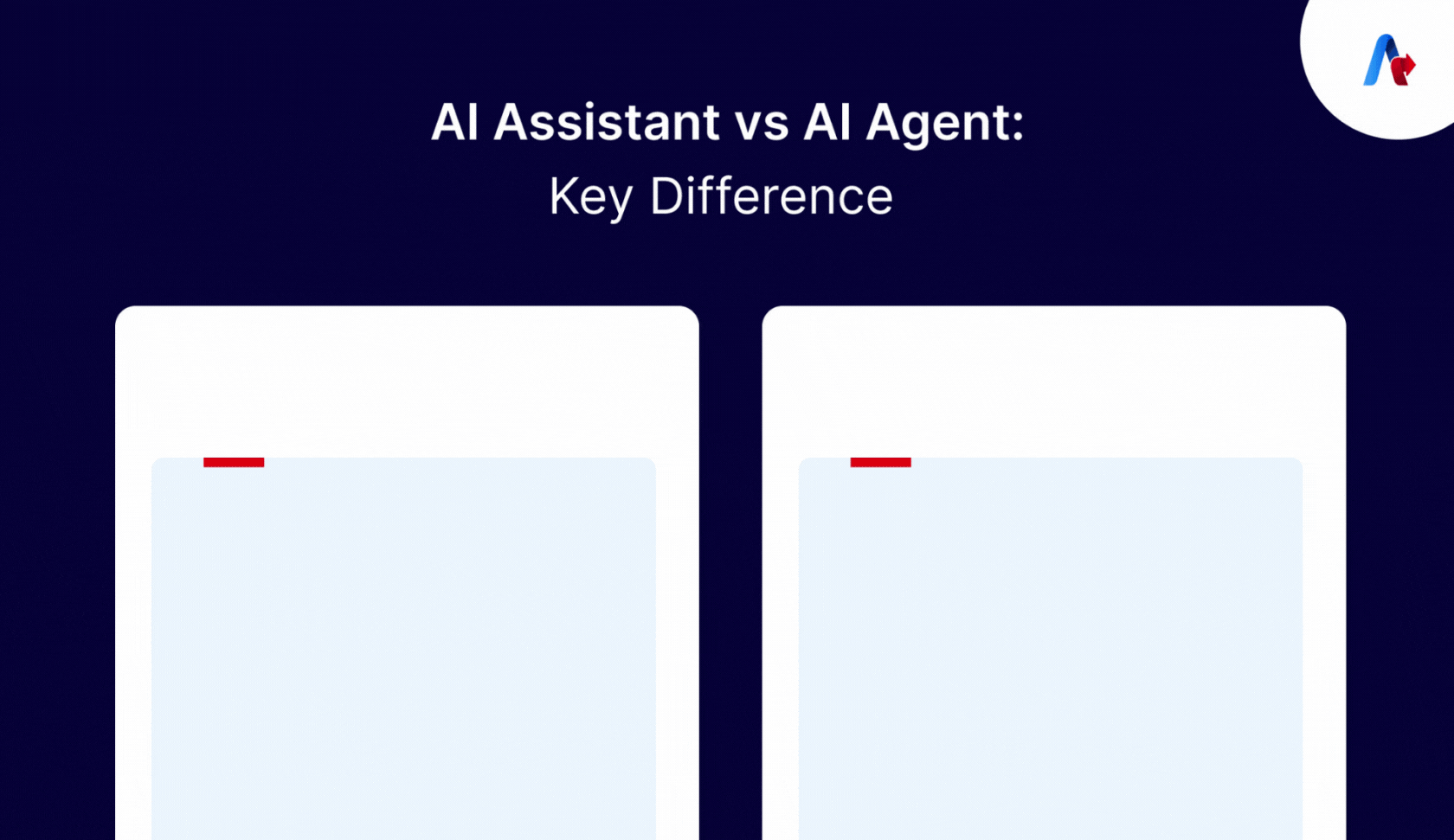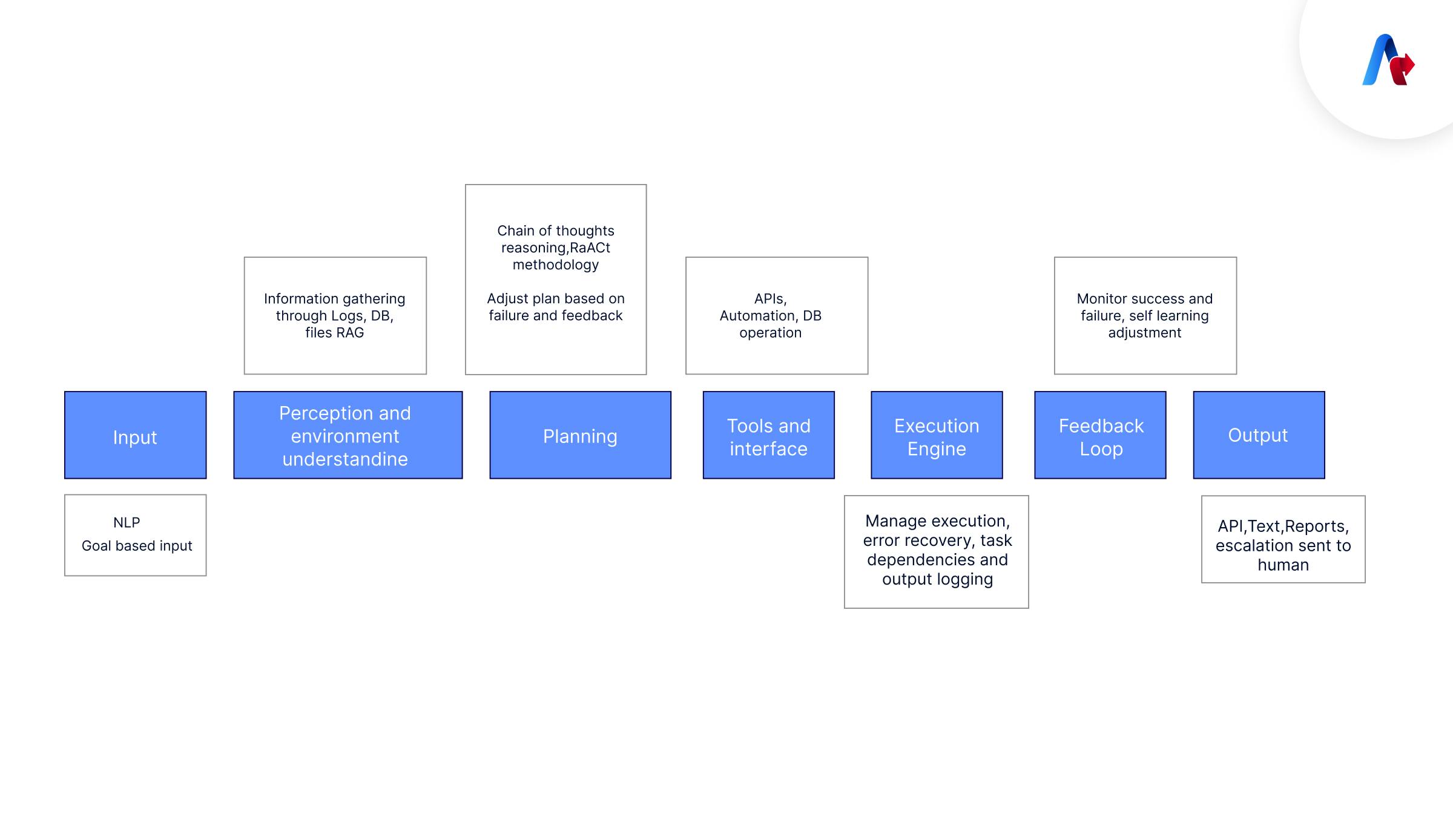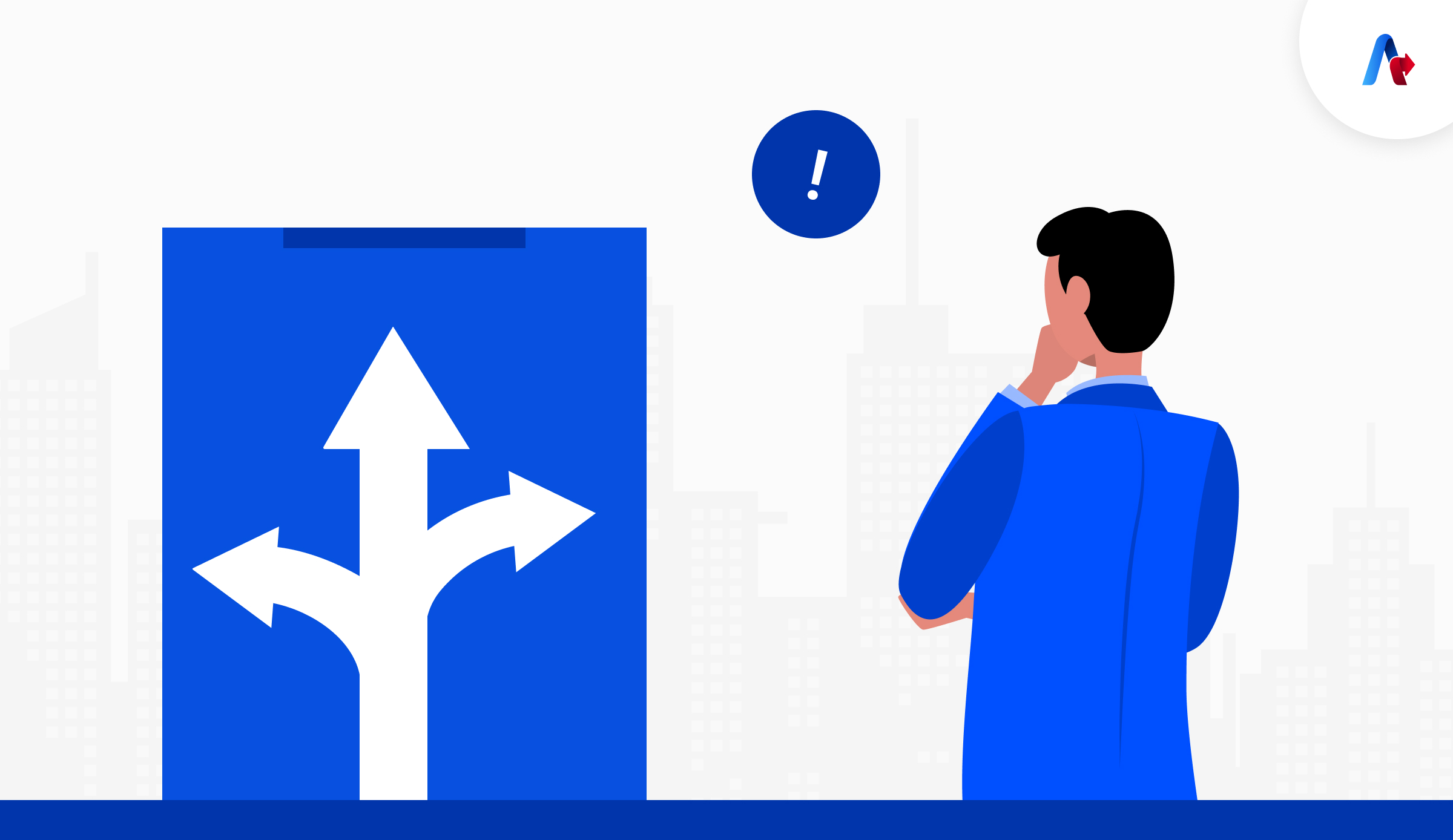AI Agents vs AI Assistants
BLOG
13 min read
AI Agents vs. AI Assistants: A Comparative Guide to Their Capabilities
Quick Summary
AI is becoming an everyday tool in how we work, communicate, and automate. But one of the biggest confusions people still face is the difference between an AI Assistant and an AI Agent. Though they may sound similar, they serve different purposes, behave differently, and are used for different types of tasks. Whether you are a product manager, automation architect, or just someone exploring AI tools for your team, understanding the core capabilities of these AI tools and their difference can help to choose the right solution for your specific needs.
As enterprises across industries have rapidly started to embrace automation for almost all verticals, there is growing confusion between AI Agents vs AI Assistants. These terms are often used interchangeably, but they are not the same. Therefore, choosing the wrong one can lead to poor outcomes, failed implementations, or inefficient systems.
This guide outlines how they function, when to use which, and how to implement them effectively in enterprise environments. It also compares their challenges, capabilities, and implementation considerations with practical examples and key differences.
Wondering where to start?
Request a use case workshop with our AI experts today!What is an AI Assistant?
Simply put, AI Assistants are your assistant for the work you do. They are reactive systems designed to execute specific tasks when instructed. They rely on predefined prompts or commands and offer support functions such as answering questions, scheduling, or summarizing content.
Key characteristics:
- Executes tasks only upon user input
- Designed to follow a set of programmed responses
- Typically used in chat interfaces or virtual assistant tools
Example: Siri, Google Assistant, ChatGPT (as a QA chatbot), or Copilot in Microsoft 365.
The limitations with the AI Assistant are they cannot make independent decisions and struggle with dynamically changing inputs.
What is an AI Agent?
AI agents are autonomous systems designed to work independently and do not exactly wait for humans to instruct them. Even with little to no prompt, they can plan, reason, and execute multi-step tasks using environmental data and goal-oriented logic.
Key characteristics:
- Proactive decision-making
- Goal-driven execution
- Interacts with multiple tools and environments
- Capable of handling complex workflows
Example: UiPath AI Agents, AutoGPT, Salesforce Einstein Copilot for multi-tool workflow automation.

AI Assistant vs. AI Agent: Core Capabilities Compared
| Capability | AI Assistant | AI Agent |
|---|---|---|
| Autonomy | Low and reactive | High and proactive |
| Task Scope | Handles single task guided by human | Handles multi-step independent task |
| Tool usage | Limited | Dynamic, multi-tool orchestration |
| Memory | Short-term, session-based | Long-term, persistent context |
| Learning | Limited | Adaptive to the environment and can act independently learning from past experiences |
| Decision-Making | User-dependent | Contextual and independent |
When Should You Use an Assistant vs. Agent?
Not every task needs a full-blown autonomous AI agent. Sometimes, a simple assistant is more than enough and easier to maintain. The key is knowing when to use each. Think of it like choosing the right tool for the job: Do you just need help when asked? Or do you want a system that can work independently and make decisions on your behalf?
Let's evaluate both based on task complexity, team workflows, available integrations, and long-term goals.
Use an AI Assistant When:
- The task is simple, repetitive, and requires user control
- You want to interact with users directly
- It doesn’t need memory or workflow orchestration
Tasks such as scheduling, Q&A assistant, and summarization are more suitable.
These tasks basically work on pre-defined inputs and do not have dynamically changing requirements.
Use an AI Agent When:
- You need the system to do things without being told step-by-step
- The task spans multiple tools, systems, or rules
- You want to save time by automating full workflows
On the other hand, Agents are more suitable for tasks such as workflow automation, multi tool orchestration and research where more independent decision making is needed and input requirements might vary from time to time.
Decision Factors: Choosing the Right System
| Factor | AI Assistant | AI Agent |
|---|---|---|
| Task complexity | Low | High and goal oriented and multi-step |
| Autonomy | Dependent on user input | Independently works |
| Memory | No need, single session | Memory to store context |
| Integration | Less | High |
| Adaptability | Work on Pre trained | Dynamic and learning capability |
How to Implement AI Assistant vs. AI Agent?
Once you know whether you need an AI Assistant or Agent, the next step is to actually build it. But how you go about setting up each is very different. Assistants are often rule-based and simpler to launch. Agents, on the other hand, require deeper planning, system integrations, and goal-based orchestration. Let’s find out what you need to know to get started with either and how to make your implementation effective without being overly complex.
Setting Up an AI Assistant
AI Assistants can process text voice commands and understand them in natural language using NLP. They determine the next step based on the logical steps and execute to generate responses such as text, voice or UI elements like cards, or any other selection for the user.

Setting up an AI Agent
AI Agents work with a different agentic architecture. They take goal-based input and understand current events. Agents can reason and adjust plans based on failure or sequence of events. They can integrate with tools to achieve autonomous systems and have an error recovery mechanism with learning capabilities. Agents generate responses in the form of API, text, reports and escalations.

Step-By-Step Guideline to Deploy AI Assistant and AI Agent
Here are the best practices to implement both these AI tools at the right place and objective.
1. Understand the fundamentals
- Understanding technology thoroughly plays an important role in how and when to implement it. Before implementation we should know the fundamentals of how and when AI assistant and AI agent are useful to implement.
2. Define use case
- Define use case in details and starts from small POC or project and make it scalable to have more features in future
- Check if it is task driven or conversational or both
- Define the goal of the use case and audience
3. Analyze and choose the components
- Decide and understand components such as LLM, NLP and their role and tools
- Plan orchestration and execution
- Define storage, think safety and interface
4. Design the system
- Design the system based on components chosen
- Design input and output layer
- Use modular design
5. Implement and Integrate
- Integrate other system when needed
- Start with small and test the integration
- Handle sensitive data
6. Test
- Test all edge scenarios
- Plan fallback behavior
- Handle failures
- Check user satisfaction score
7. Monitor and improve
- Track completion rate, Latency, tool, API error and escalation
- Improve feedback loops, fine tune solution
Ready to deploy AI Agents in just 5 weeks?
Try AI Agent Activator Program today!Key Challenges and Considerations for Better Outcomes
As useful as they are, AI Assistants and Agents each come with their own risks and limitations. Whether it’s assistants giving vague answers or agents failing to recover from a broken tool, knowing the potential roadblocks upfront can save you frustration (and budget).

Here are some of the most common issues people face when deploying each type and how to plan ahead to avoid them.
AI Assistant
- Has limited context: It works on logical configurable steps and generates response
- Has static interaction: it has predictable Reponses and unable to drive proactive conversation
- Narrow task handling is difficult to scale: It is designed with pre-defined action and programmed accordingly. It cannot handle unexpected or new scenarios
- It might misinterpret intent of user input: Can generates ambiguous output when some random/incomplete question asked
- Poor error handling: If something asked randomly it cannot generate proper response instead it gives generic response that “I don't understand”
- Lack of personalization: It cannot be personalized based on each user need
- Not easy to maintain
AI Agent
- Need better planning and reasoning to cover all edge cases: Sometimes it struggles to cover all edge cases scenarios and failed in some circumstances
- Tool integration and orchestration management: Integration dependency of many tools will lead to failure. Managing it technically is difficult
- Human in the loop management: Human is still needed to take critical decision on highly sensitive data and managing this is tricky
- Difficult to audit the steps taken by agent: It is hard to find how agent comes to specific outcomes why and how?
- Testing challenges: As content gets generated dynamically it is hard to test all scenarios
- Data dependency and Hallucination
- Security risks: Can accidentally leak or misuse data
Real-World Examples of AI Assistant and AI Agent
Theory is helpful but what does this actually look like in practice? In this section, we walk through real-world use cases for both assistants and agents to show how they’re being used in businesses today. These examples will help you visualize what kind of value you can expect, and where each type shines.
AI Assistant: ChatGPT/Co-Pilot
ChatGPT is a widely used interface and considered as knowledge base for various things. It is chat interface By Open AI which has large data set on which it trained to respond to variety of topics.
ChatGPT understands the user’s query in natural language and runs algorithms to fetch relevant data from the knowledge base. Even if it has tons of data which it trained to provide answers to anything, it has its own limitations.
- It can only answer query based on data it has in knowledge base
- It can hallucinate or overconfident in answers.
- It is not adaptable or not understand current events
- Always waits for user input and do not take any independent decision
- Privacy is at risk
- Difficult to restrict ChatGPT to answer based on your task goal
AI Agent: UiPath AI Agent/AutoGPT
When any task is given to agent, it does below:
- Understanding Goal: understand and interpret task in natural language
- Plan: Break task in sub task and search, analyze and collect the data
- Execute: Use tools to complete task, store results, and respond to user
- Feedback loop: Rewrite the response if needed and adjust according to user needs.
AI agents focus on goals that need to be achieved. One Agent should represent one goal
Emerging Trends in AI Application
WIth the rising popularity and demand for AI tools, there is a new trend and update every single day. But here are a few trends worth noticing right away.
- Convergence of Assistants and Agents: New systems blend conversational UI with autonomous planning.
- Rise of Hybrid AI Architectures: Balancing rule-based workflows with LLM-driven reasoning for better accuracy.
- Multi-Agent Ecosystems: Different agents managing distinct business functions (e.g., finance, operations, support).
- Embedded AI Agents: AI embedded within platforms like Salesforce or ServiceNow, enabling native automation.
Picking the Right AI for the Right Task
AI Assistants and AI Agents are both valuable, but they serve different purposes. Assistants are ideal for straightforward, human-guided interactions, while Agents excel at managing end-to-end agentic workflows with minimal supervision. The future will likely include hybrid systems where Assistants and Agents work in tandem, offering businesses the flexibility of reactive communication and proactive execution.
Selecting the right tool for the right job is essential. As more tools become capable of both roles, defining the scope and purpose early in the design process will be key to success. Associating with a trusted AI Agent implementation partner can help establish a strategic roadmap for better decision-making.
Still not sure what you need?
Talk to our experts for quick guidanceFAQs
AI Assistants are reactive tools that perform specific tasks only when prompted by the user. They follow predefined logic or workflows and are typically used for tasks like answering queries, summarizing content, or scheduling.
AI Agents, on the other hand, are autonomous and goal-driven. They proactively make decisions, adapt to environments, and handle complex workflows across multiple tools without needing constant human input.
ChatGPT (especially in its default usage) is an AI Assistant. It relies on user prompts, responds in natural language, and doesn’t take autonomous actions unless integrated into a broader agentic system. It does not have memory persistence or decision-making autonomy unless extended via tools or APIs.
Some of the most popular AI Assistants include ChatGPT by OpenAI, Google Assistant, Siri by Apple and Microsoft Copilot for 365. These tools help users interact with systems conversationally, usually for information retrieval, task assistance, and summarization.
AI Assistants can respond to user queries, summarize information, schedule meetings, retrieve documents and help users complete simple tasks. They are especially effective for human-guided, low-complexity use cases that don’t require multiple steps or tool orchestration.
The key capabilities of AI Assistant include understanding and processing natural language, providing rule-based or scripted responses, executing predefined tasks upon instruction, delivering output in formats like text, UI prompts, or voice. However, they lack autonomy, don’t retain memory across sessions, and struggle with dynamically changing inputs.
Not directly. While AI Assistants and Agents may share foundational technologies like NLP or LLMs, Assistants are not inherently designed for autonomous action.
That said, they can be part of a broader agentic system. For example, an Assistant could serve as the front-end interface to trigger AI Agent-driven workflows in the backend. This hybrid model is a rising trend in enterprise automation.
It depends on the complexity and autonomy required for the task:
- Use an AI Assistant if the task is simple, requires user control, and doesn’t span multiple systems. Think scheduling, Q&A, or summarization.
- Use an AI Agent if the task involves multiple steps, tools, or decisions—and needs to run independently with minimal human input. Think workflow automation, orchestration, or data processing.
Quick Tip: Start with a clear use case. If it needs memory, reasoning, or multi-tool action, go with an Agent.



